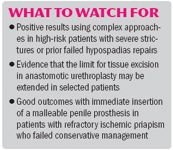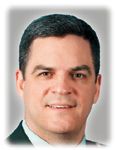Article
Reconstruction: Complex approaches yield good results
Clinical research in the field of trauma and reconstructive urologic surgery shows a recent focus on challenging cases, and study results are providing useful insight about their management, said Allen F. Morey, MD.
Clinical research in the field of trauma and reconstructive urologic surgery shows a recent focus on challenging cases, and study results are providing useful insight about their management, said Allen F. Morey, MD.

"In addition, we are seeing early benefits of novel therapies for refractory priapism, and we can expect to hear more about those approaches in the future," said Dr. Morey, chief of urology, Brooke Army Medical Center, San Antonio.

Anastomotic urethroplasty In addition, look for reports suggesting that the limit for tissue excision in anastomotic urethroplasty may be extended in selected patients. Dr. Morey will be presenting data from a study showing that defects of up to 5 cm can be successfully excised and primarily reconstructed. His experience will be corroborated by investigators from another center who are reporting outcomes in men who have undergone excision and primary anastomosis for treatment of anterior urethral strictures ranging up to 4.5 cm in length.
"However, extended anastomotic urethroplasty should probably be limited to young, sexually active men who have proximal bulbar strictures and thus provide a maximal amount of well-vascularized, elastic tissue available for retrograde mobilization to bridge the defect," Dr. Morey noted.
Several groups are reporting reassuring data on a general lack of significant adverse sexual outcomes following urethroplasty. Not only does the incidence of erectile dysfunction appear to be low, but when it occurs, it appears to be transient and resolve with time.
"These findings suggest that few patients have lasting sexual problems after urethroplasty, and that engaging in sexual activity and the presence of normal erections has a positive effect for ameliorating any transient difficulties that can occur, probably secondary to erections acting as a tissue expander," Dr. Morey said.
He also drew attention to an upcoming retrospective study of outcomes after artificial urinary sphincter placement in a large series of men who had received prior radiation therapy for prostate cancer. The results indicate that risks for sphincter cuff erosion or atrophy were not substantially greater than in patients who had not been radiated.
"Some urologists have been reluctant because of concern about an increased risk of failure. These data indicate such a history should not preclude men from being offered this procedure," Dr. Morey said.
In the area of priapism management, Dr. Morey said urologists can look forward to hearing more about immediate insertion of a malleable penile prosthesis in patients with refractory ischemic priapism who have failed conservative management. At the AUA meeting, one group will report excellent results and high patient satisfaction with such an approach in men who failed treatment with aspiration and phenylephrine instillation.
"These are encouraging outcomes for a challenging group of men who would otherwise likely have gone on to develop progressive fibrosis and severe erectile dysfunction," Dr. Morey said.
Another report will review outcomes from a small series of patients with traumatic high-flow priapism treated with superselective embolization of the arterial-lacunar fistula. The procedure was done in conjunction with pudendal angiography and performed at an average of about 9 days after onset of priapism. Although more than half of the men required a second embolization procedure, all achieved detumescence without immediate complications, and during long-term follow-up, nearly three-fourths of the men regained normal erectile function.




